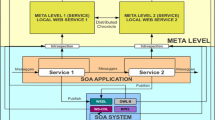Abstract
Systems designed to be self-healing are able to heal themselves at runtime in response to changing environmental or operational circumstances. Thus, the goal is to avoid catastrophic failure through prompt execution of remedial actions. This paper proposes a self-healing mechanism that monitors, diagnoses and heals its own internal problems using self-awareness as contextual information. The self-management system that encapsulates the self-healing mechanism related to reliability improvement addresses: (1) Monitoring layer, (2) Diagnosis & Decision Layer, and (3) Adaptation Layer, in order to perform self-diagnosis and self-healing. To confirm the effectiveness of self-healing mechanism, practical experiments are conducted with a prototype system.
This work was supported in parts by Ubiquitous Autonomic Computing and Network Project, 21th Century Frontier R&D Program, MIC, Korea, ITRC IITA-2005-(C1090-0501-0019), Grant No. R01-2006-000-10954-0, Basic Research Program of the Science & Engineering Foundation.
Preview
Unable to display preview. Download preview PDF.
Similar content being viewed by others
References
IBM: Autonomic Computing: IBM’s Perspective on the State of Information Technology, http://www.ibm.com/industries/government/doc/content/resource/thought/278606109.html
Kephart, J.O., Chess, D.M.: IBM Thomas J. Watson Research Center: The Vision of Autonomic Computing. IEEE Computer Society (January 2003)
Oreizy, P., et al.: An Architecture-Based Approach to Self-Adaptive Software. IEEE Intelligent Systems 14(3), 54–62 (1999)
Garlan, D., Schmerl, B.: Model-based Adaptation for Self-Healing Systems. In: Proceedings of the First ACM SIGSOFT Workshop on Self-Healing Systems (WOSS), South Carolina, pp. 27–32 (November 2002)
Abowd, G.D., Allen, R., Garlan, D.: Formalizing style to understand descriptions of software architecture. ACM Transactions on Software Engineering and Methodology 4(4), 319–364 (1995)
Batory, D., O’Malley, S.: The Design and Implementation of Hierarchical Software Systems with Reusable Components. ACM Transactions on Software Engineering and Methodology 1(4), 355–398 (1992)
Bernardo, M., Ciancarni, P., Donatiello, L.: On the formalization of architectural types with process algebras. In: Proceedings of the 8th International Symposium on Foundations of Software Engineering, pp. 140–148 (November 2000)
Topol, B., Ogle, D., Pierson, D., Thoensen, J., Sweitzer, J., Chow, M., Hoffmann, M.A., Durham, P., Telford, R., Sheth, S., Studwell, T.: Automating problem determination: A first step toward self-healing computing system. IBM white paper (October 2003)
Baekelmans, J., Brittenham, P., Deckers, T., DeLaet, C., Merenda, E., Miller, B., Ogle, D., Rajaraman, B., Sinclair, K., Sweitzer, J.: Adaptive Services Framework CISCO white paper (October 2003)
Hillman, J., Warren, I.: Meta-adaptation in Autonomic systems. In: Proceedings of the 10th International Workshop on Future Trends in Distributed Computer Systems (FTDCS), Sozhou, China, May 26-28 (2004)
Garlan, D., Cheng, S.-W., Schmerl, B.: Increasing System Dependability through Architecture-based Self-repair. In: de Lemos, R., Gacek, C., Romanovsky, A. (eds.) Architecting Dependable Systems. LNCS, vol. 2677. Springer, Heidelberg (2003)
Bellifemine, F., Caire, G., Trucco, T.: (TILAB, formerly CSELT) Giovanni Rimassa (University of Parma). Jade Programmer’s Guide
Parnas, D.: Designing Software for Extension and Contraction. In: 3rd International Conference on Software Engineering, pp. 264–277 (1978)
Kiczales, G., Lamping, J., Mendhekar, A., Maeda, C., Lopes, C.V., Loingtier, J.-M., Irwin, J.: Aspect-Oriented Programming. In: Aksit, M., Matsuoka, S. (eds.) ECOOP 1997. LNCS, vol. 1241, pp. 220–242. Springer, Heidelberg (1997)
Wang, Q.: Towards a Rule Model for Self-adaptive Software. ACM SIGSOFT Software Engineering Notes Page 30(1), 1–5 (2005)
Author information
Authors and Affiliations
Editor information
Editors and Affiliations
Rights and permissions
Copyright information
© 2006 Springer-Verlag Berlin Heidelberg
About this paper
Cite this paper
Park, J., Yoo, G., Jeong, C., Lee, E. (2006). Self-management System Based on Self-healing Mechanism. In: Kim, YT., Takano, M. (eds) Management of Convergence Networks and Services. APNOMS 2006. Lecture Notes in Computer Science, vol 4238. Springer, Berlin, Heidelberg. https://doi.org/10.1007/11876601_38
Download citation
DOI: https://doi.org/10.1007/11876601_38
Publisher Name: Springer, Berlin, Heidelberg
Print ISBN: 978-3-540-45776-3
Online ISBN: 978-3-540-46233-0
eBook Packages: Computer ScienceComputer Science (R0)




